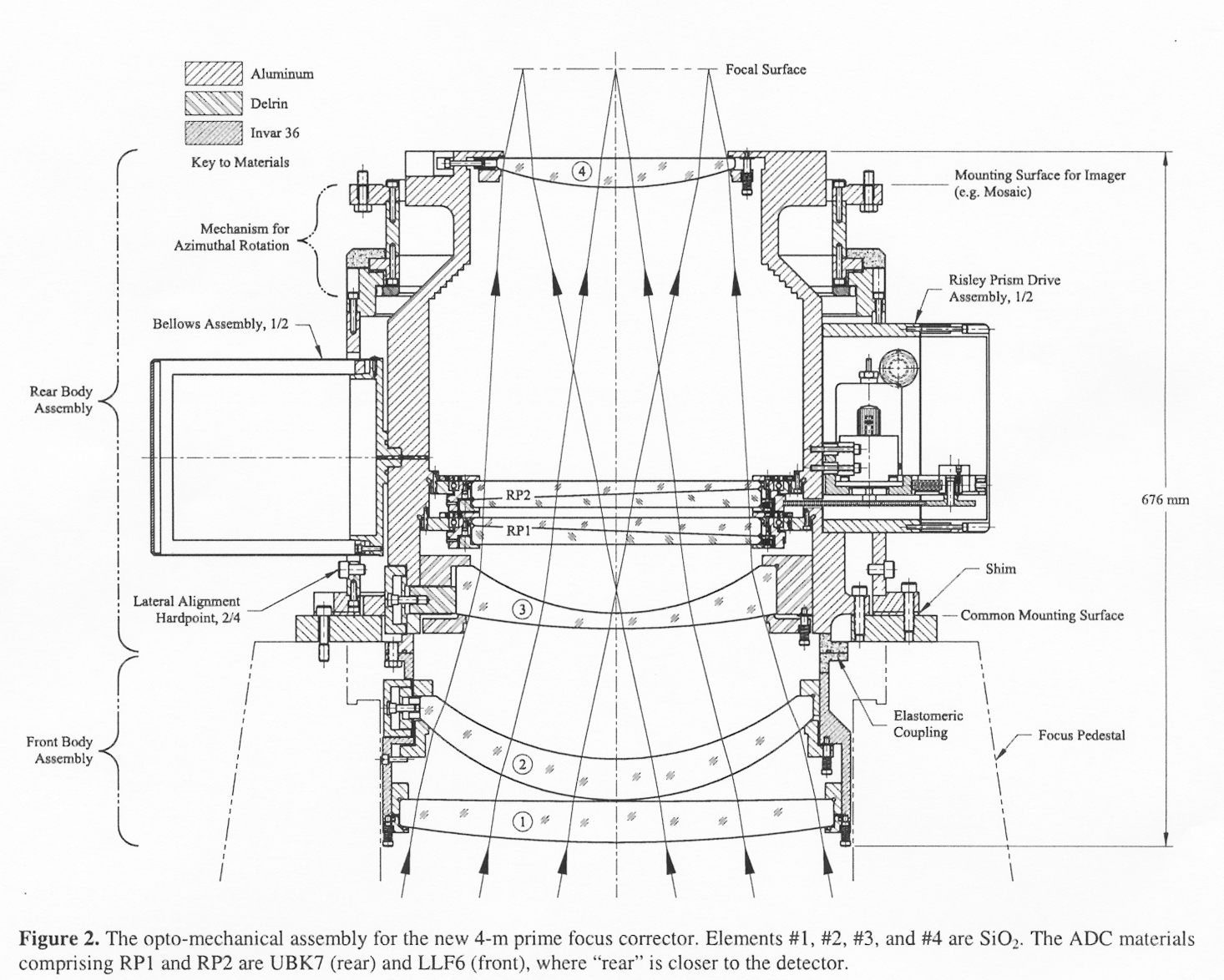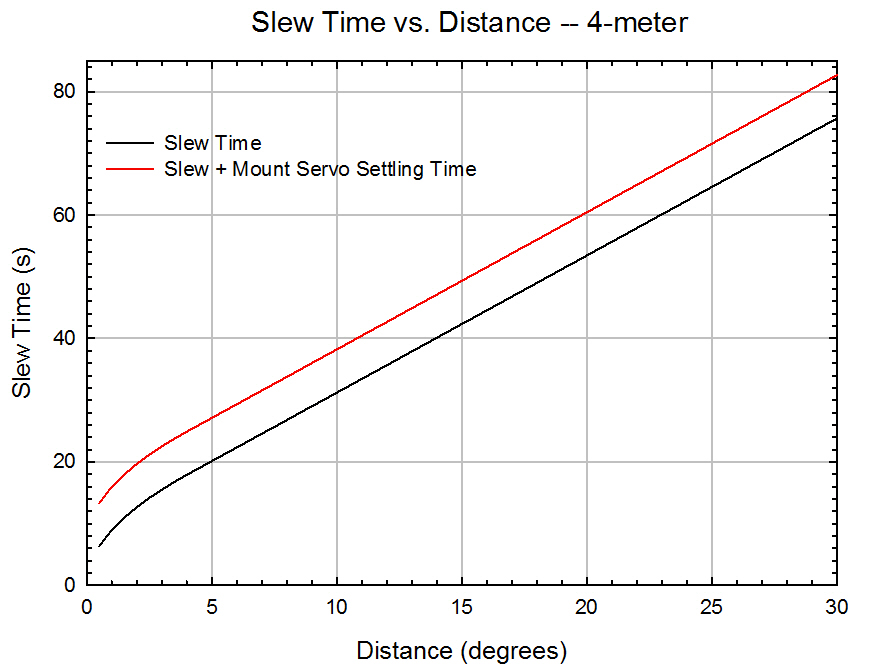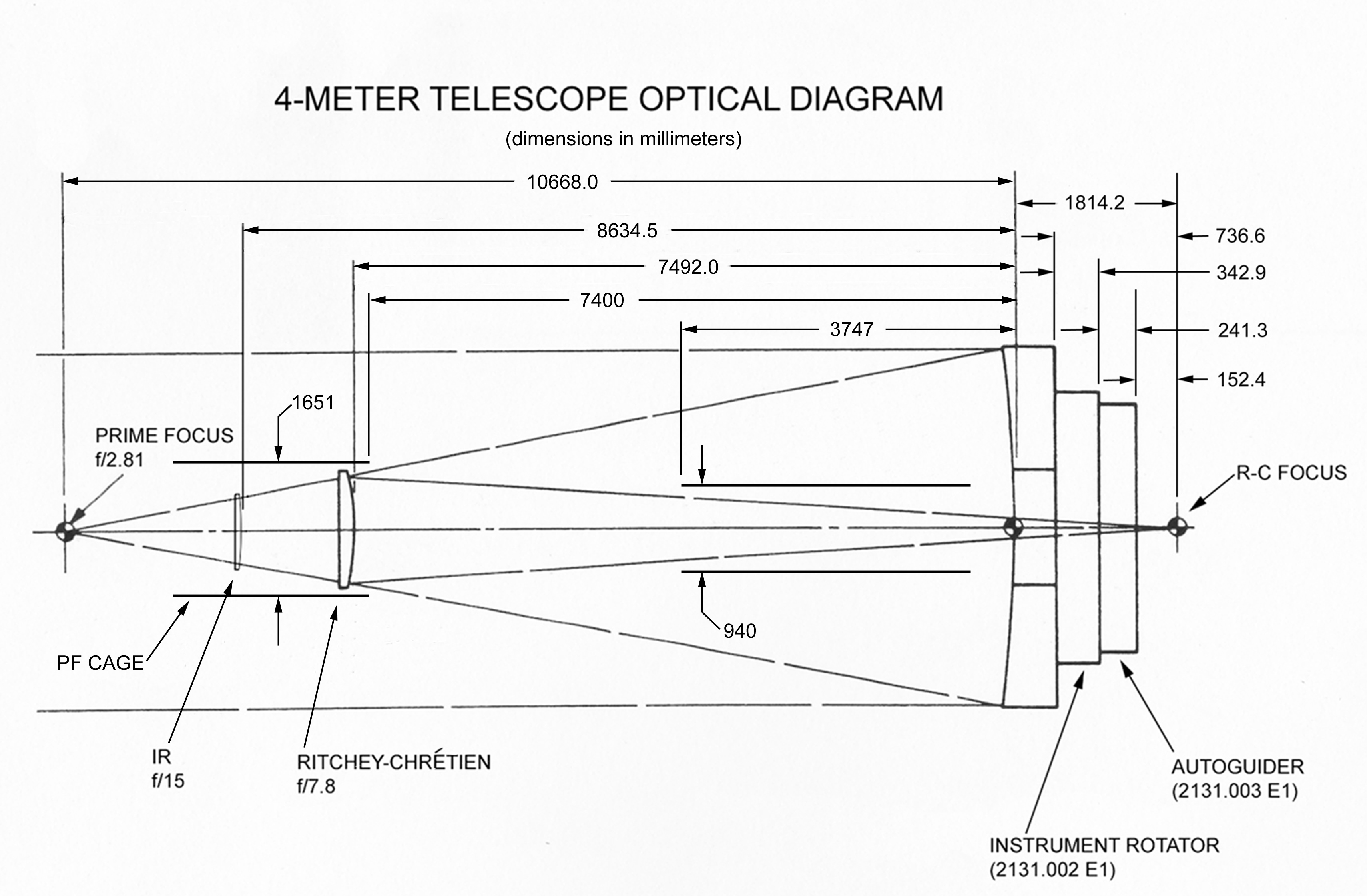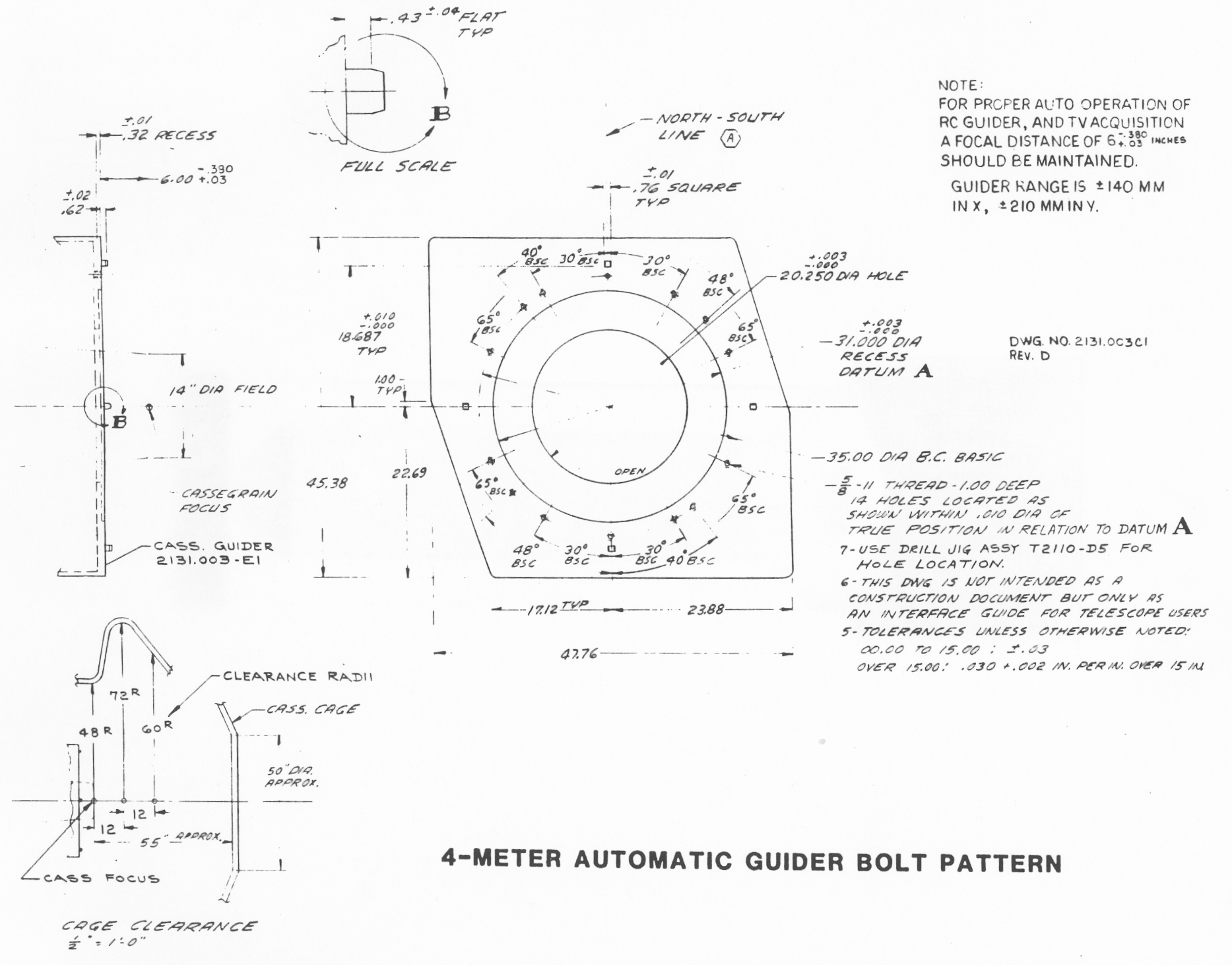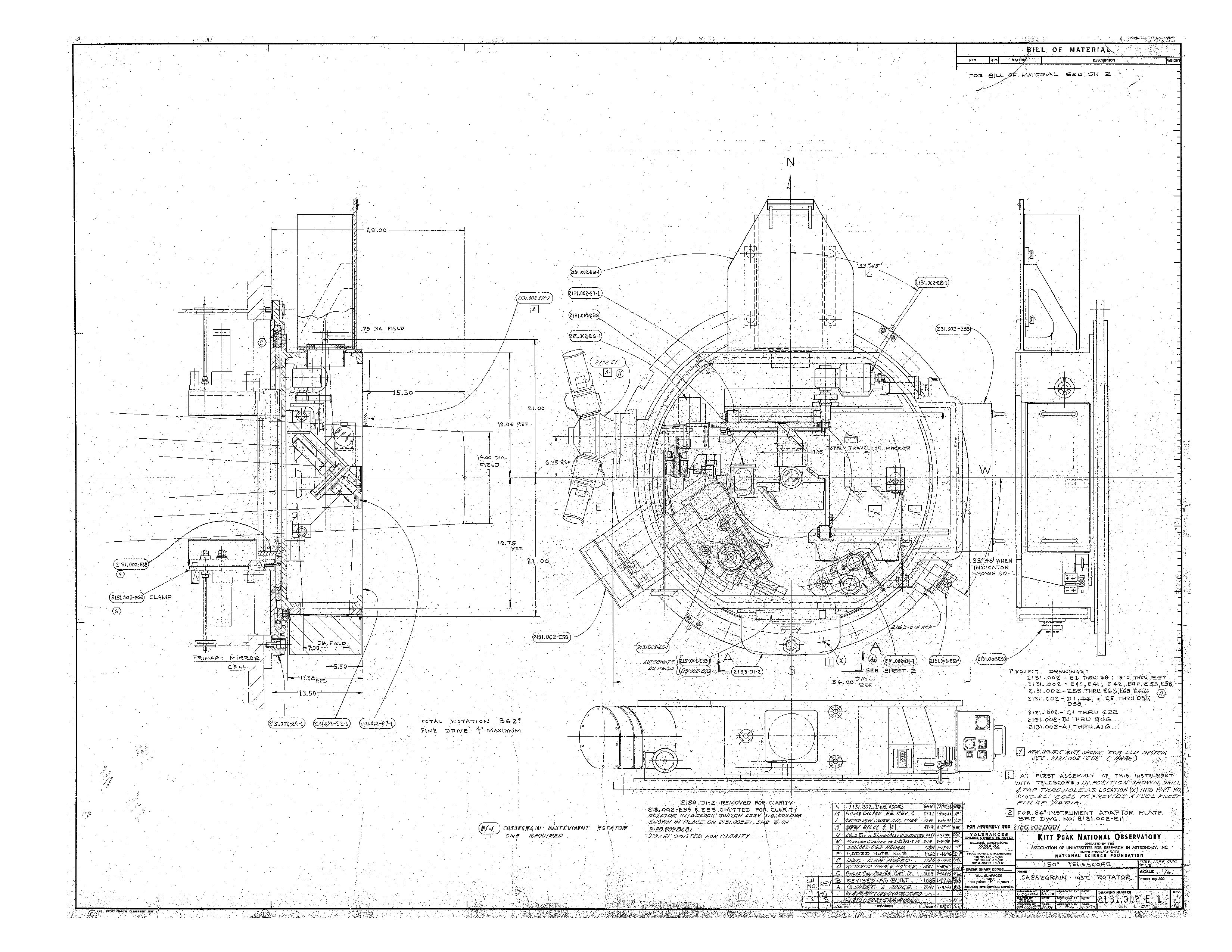KPNO 4 Meter Mayall - Basic Parameters and Facts
This page describes the current 4 Meter configuration
- Design concepts for very wide field Prime Focus and Cassegrain configurations
- Additional facts relevant to possible use of the 4 Meter for large science programs
Location:
Longitude: 111:35:59.6 W, Latitude: 31:57:50.5 N, Altitude: 2123.2m MSL
Basic Optical Data
Prime Focus (f/3.1) Corrector and ADC PrismsOpto-Mechanical Assembly - 4 Meter Prime Focus Corrector The 4-m prime focus corrector is described in Jacoby, Liang, Vaughnn, Reed, and Armandroff (1988 SPIE, 3355, 721). Slew TimeCalculated slew and servo settling time for the 4-meter telescope with the new Mayall Active Primary Support (MAPS) implementation. Slew motion occurs in both HA and DEC simultaneously, so the time estimate should use the longer of the two motions. South East Annex PositionThe position of the telescope when at the South East Annex is: |
4MAPS - 4 Meter Active Primary System4MAPS Manual (NOAO only) Risley Prisms - Cass Focus
TelescopeCassegrain Cage Mechanical Data
* datum=back of primary mirror cell
The primary mirror is 4.002 m diameter, 0.6 m thick, with a 1.324 m central hole. It is made of solid fused quartz and weighs 29800 pounds (13514 kg). The focal length is 10.659 m. The interior radius of the dome is 51 feet (15.5 m). The exterior radius is 54 feet (16.5 m). The dome weighs 500 tons (453 metric tons) and is supported on 32 rolling trucks. The moving weight of the Mayall telescope is 375 tons.
|
|||||||||||||||||||||||||||||||||||||||||||||||||||||||||||||||||||||||||||||||||||||||||||||||||||||||||||||||||||||||||||||||||||||||||||||||||||||||||
Mayall HA Operation Limits |
||
|---|---|---|
Declination |
Lower Shutter Up
|
Lower Shutter Down
|
| +80 | 6:20 | 6:20 |
| +70 | 6:20 | 6:20 |
| +60 | 5:50 | 6:20 |
| +50 | 5:40 | 6:20 |
| +40 | 5:15 | 6:05 |
| +30 | 4:50 | 5:35 |
| +20 | 4:35 | 5:10 |
| +10 | 4:15 | 4:50 |
| 0 | 3:45 | 4:20 |
| -10 | 3:10 | 4:00 |
| -20 | 2:25 | 3:15 |
| -30 | 0:30 | 2:20 |
| -40 | --- | --- |
* Note: The Airmass=2.1 limit was determined for Mosaic3. For DESI, with its 1.5 degree field, it's advised to point only to targets of airmass < 2.0 with the lower shutter raised.
DESI:
The DESI focal plane is 840 mm in diameter, covering 3 degrees on the sky. It consists of 10 pie-shaped “petals”, each of which has 500 fiber actuators, 12 fixed “fiducial” fibers used to calibrate the locations of the actuators, and a CCD imager which is used to position the telescope to the desired position and ensure it is focused. The 500 fibers from each petal are wrapped in a 26 mm diameter cable 50 m long which delivers the light to one of the 10 spectrographs.
Each fiber subtends about 1.5 arcseconds on the sky and can be positioned to an accuracy of 0.05 arcsec. The positioners use two small motors to position a fiber within a patrol range 12 mm (171 arcsec) in diameter. They are typically spaced by about 10.5 mm (150 arcsec) to achieve full coverage of the focal plane. The positioning software stages the motions to avoid collisions between adjacent positioners.
Each spectrograph covers the 360 – 980 nm spectral range with a resolution between 3500 and 5000. Two dichroics are used to split the spectrum into three wavelength bands, each of which is dispersed by a grating and focused by a camera specifically optimized for that particular range of wavelengths to maximize the efficiency. The CCD detectors are also chosen for best performance in their wavelength range. Each CCD is cooled by a mechanical refrigerator to approximately -100 C to reduce the noise.
The 10 spectrographs are housed in a room temperature controlled to a precision of 0.1 C to avoid thermal expansion effects that would move the spectra on the detectors.
In between observations, a LED inside each spectrograph back-illuminates the fibers, which are imaged by a camera mounted in the Cassegrain Cage of the telescope. The actual position of each fiber is compared to the position predicted from the known coordinates of the target galaxies, and a series of small motions moves the fibers to the correct position.
Typical DESI exposures are 18 – 20 minutes long. After each exposure is done, the CCDs are read out, the telescope is moved to the next field, guide stars are acquired and the telescope is moved to the correct position, the fibers are back-illuminated, imaged, and tweaked to the target positions. These steps are done in parallel so DESI is able to start a new exposure within 2 minutes of completing the previous one.
Updated on July 14, 2024, 7:51 pm
